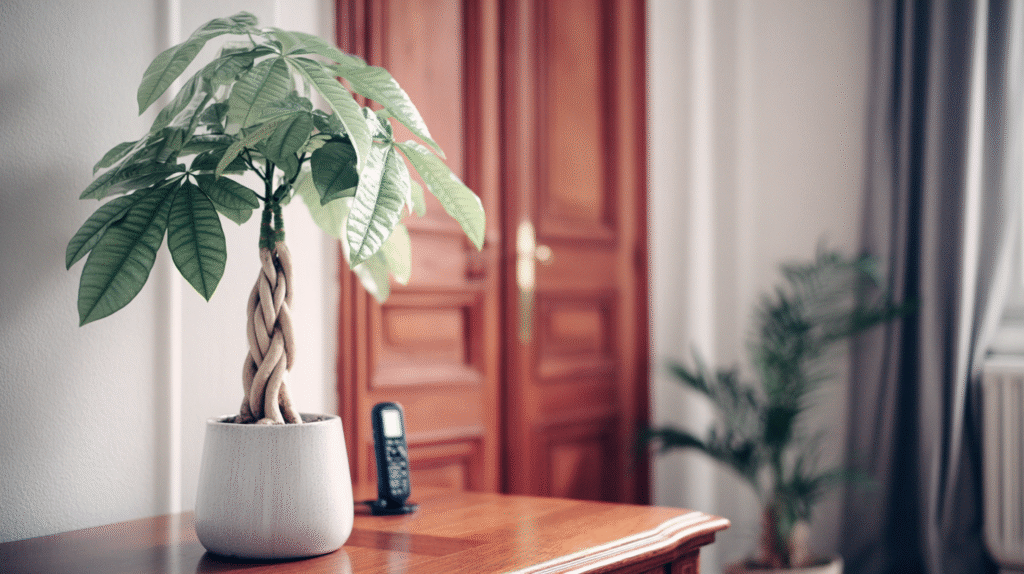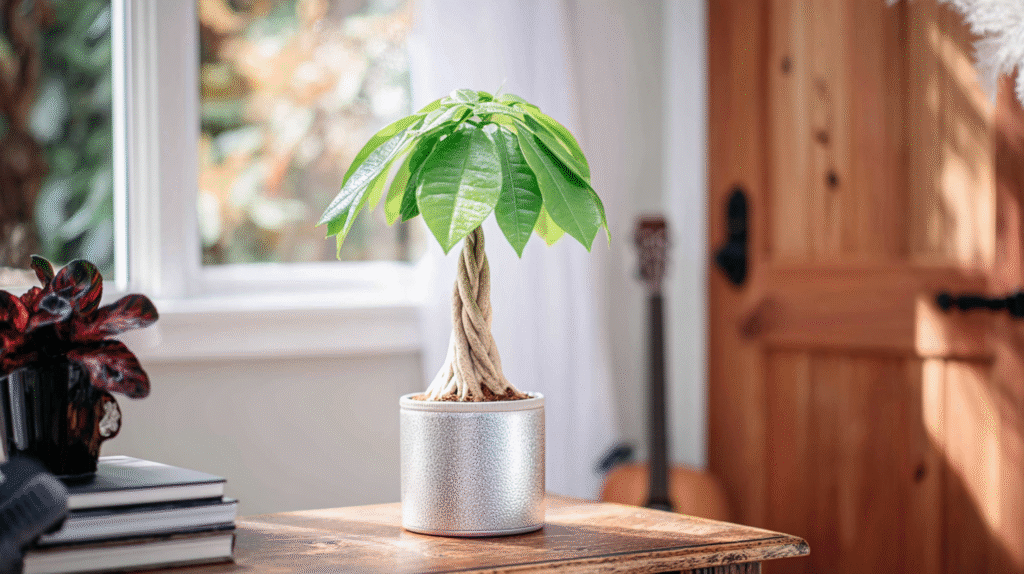Let me paint you a picture: It’s 2020, lockdown is in full swing, and I’m staring at my third dying Pachira aquatica (aka Money Tree) in six months. This was supposed to be the “un-killable” beginner plant, yet here I was, watching another one turn into a crispy, yellowed mess.
The lady at the plant shop had promised it would bring good fortune. The only fortune I was bringing was to the garden center’s cash register as I kept buying replacements.
After murdering four more Money Trees (yes, four—I kept receipts), something finally clicked. Today, my living room boasts a five-foot-tall Pachira that survived two moves, a cat attack, and my chronic overwatering habit. Turns out, the secret wasn’t in some mystical care routine. It was in finally understanding what these plants actually want versus what everyone tells you they need.

The Money Tree Lies Nobody Talks About
Every plant influencer says the same thing: “Perfect for beginners!” “Thrives on neglect!” “Brings good fortune!” What they conveniently skip? The dramatic leaf drop when you move it two inches. The root rot that strikes faster than you can say “weekly watering schedule.” The way it leans like it’s doing the limbo if you don’t rotate it.
Here’s the truth bomb: Money Trees are easy… once you stop treating them like a decorative object and start treating them like the weird tropical tree they actually are.
Watering: Where 90% of People Screw Up
My first mistake? Following that “water once a week” advice like it was gospel.
Big, huge, plant-murdering mistake.
Money Trees don’t read calendars. Summer in my apartment meant weekly watering worked. Winter? That same schedule had me growing mushrooms in the pot. Literally. Actual mushrooms.
What actually works: The knuckle test saved my sanity.
Dry up to your second knuckle? Water. Still damp? Walk away. Seriously, just walk away.
I switched to bottom watering, and holy crap, game changer.
Once a month, I sit mine in about 2 inches of water for 20 minutes.
The plant drinks what it needs, no more root rot from water sitting on top. Plus, it forces all those roots to grow down instead of staying surface-level.
Winter means I might water every 3-4 weeks. Summer can be weekly. Spring and fall? Somewhere in between.
The plant tells you when it’s thirsty
the leaves get a little less perky, not full-on droopy, just slightly sad. That’s your cue.
Light: The Goldilocks Zone Nobody Explains Properly
“Bright indirect light” is the most useless plant advice ever. What does that even mean? Here’s what actually works:
My Money Tree lives about 4 feet from an east-facing window. It gets maybe an hour of direct morning sun (gentle stuff, not scorching), then bright shade the rest of the day. When I had it in lower light, it grew exactly one new leaf in six months. One. Sad. Leaf.
Too much direct sun? The leaves bleach out and get crispy. Too little light? Barely any growth and definitely no new leaves on those braided trunks. You want that sweet spot where you could comfortably read a book without squinting.
Pro tip: Those braided trunks everyone loves? They need good light to keep growing evenly. Otherwise, you get one trunk going crazy while the others sulk.

Humidity Hacks That Actually Work
You don’t need a $200 humidifier or some complicated misting schedule. My Money Tree thrives with:
A pebble tray (fancy term for a saucer with rocks and water). The pot sits on the pebbles, not in the water. As water evaporates, boom—humidity.
Plant friends. I group my plants together like they’re having a party. They create their own little microclimate. My Money Tree lives next to a peace lily and a pothos. They’re all happy.
Skip the misting. I know everyone says to mist, but water sitting on those leaves can cause fungal issues. Ask me how I know. (Spoiler: leaf spot disease is not fun.)
The Soil Situation Everyone Gets Wrong
That bag of “indoor potting mix” at the store? Too heavy for Money Trees. They want drainage, not a swamp.
My mix that hasn’t failed me yet:
- 2 parts regular potting soil
- 1 part perlite
- 1 part orchid bark
- Handful of charcoal chunks (prevents that musty smell)
This drains fast but holds just enough moisture. No more mushroom farms, no more root rot, just a happy tree.
Temperature and Placement Drama
Money Trees are bigger babies about drafts than my grandmother. Cold air from a window? Instant leaf drop. Hot air from a heating vent? Crispy leaves. Air conditioner blowing on it? Might as well throw it in the trash now.
Mine lives in the most boring spot—away from all windows, vents, and doors. Stable temperatures between 65-80°F. Not exciting, but my Money Tree hasn’t dropped a leaf in protest in over a year.
Also, rotate it. Every time I water, I give it a quarter turn. Otherwise, you get the Leaning Tower of Money Tree, reaching desperately toward the light.
Feeding Without Killing
I nearly nuked my first Money Tree with fertilizer. Turns out “more food = more growth” is a lie that leads to fertilizer burn.
Spring and summer: Liquid fertilizer at quarter strength every month. Yes, quarter. Not half, definitely not full strength.
Fall and winter: Nothing. Nada. Let it chill.
Best discovery? Worm casting tea. Once every couple of months, I water with this stuff, and the growth is insane. Plus, it’s basically impossible to burn your plant with it.
The Pruning Truth
Everyone’s scared to prune their Money Tree. I get it—you finally got it growing, why risk it? But here’s the thing: pruning makes it bushier and fixes that leggy, reaching look.
Spring is prime time. Cut just above a node (where leaves grow from). New growth will pop out below the cut. I turned my single-stem sadness into a bushy beauty with strategic snips.
Yellow or damaged leaves? Pull them off anytime. The plant wastes energy trying to keep dying leaves alive. Help it out.
Common Problems and Real Solutions
Yellow leaves falling off: Usually overwatering. Let it dry out more between waterings. If the trunk feels soft, you’ve got rot. Unpot immediately, cut away mushy roots, repot in dry soil.
Brown, crispy leaf tips: Probably tap water. These plants are sensitive to chemicals. I switched to filtered water, problem solved.
Leaves dropping but soil is dry: Check for spider mites. These jerks love Money Trees. Monthly shower in the bathroom prevents most pest issues.
Not growing: Needs more light or it’s root-bound. Check if roots are circling the pot. If yes, time to upgrade.
Trunk getting soft: Stop watering immediately. This is rot city. Sometimes you can save it by cutting above the soft part and rerooting.

Real Questions From Real People
How often should I repot? Every 2-3 years, or when you see roots coming out the drainage holes. Go up just one pot size they like being slightly snug.
Can the braided trunk be undone? Technically yes, but why? If one trunk dies, you can carefully remove it, but unbraiding healthy trunks usually damages them.
Why no new leaves? Either not enough light or it’s winter. Money Trees basically hibernate in low light or cold. Be patient.
Is it really lucky? Well, I haven’t won the lottery, but I also haven’t killed this plant in two years. That feels pretty lucky to me.
Pet safe? Good news yes! One of the few pretty plants that won’t poison your fur babies.
The Bottom Line
Money Trees aren’t hard. They’re just particular about a few things.
Get the watering right (less than you think), give them decent light (more than you think), and stop moving them around. That’s literally 90% of success right there.
My journey from serial Money Tree killer to someone whose plant actually looks like the pictures took patience and a lot of dead plants.
But now? This thing grows like it’s trying to reach my ceiling. New leaves unfurl constantly. People ask if it’s real.
Start with good drainage and err on the side of underwatering. Everything else you can adjust as you go. Your Money Tree will tell you what it needs yellow leaves mean too much water, no growth means more light, crispy edges mean check your water quality.
Just remember: it’s called a Money Tree, not a Money Bush. Let it grow tall, keep it slightly dry, and maybe it’ll bring you better fortune than it brought me. At minimum, you’ll have a cool plant that doesn’t die every three months. In my book, that’s fortune enough. 🌳






